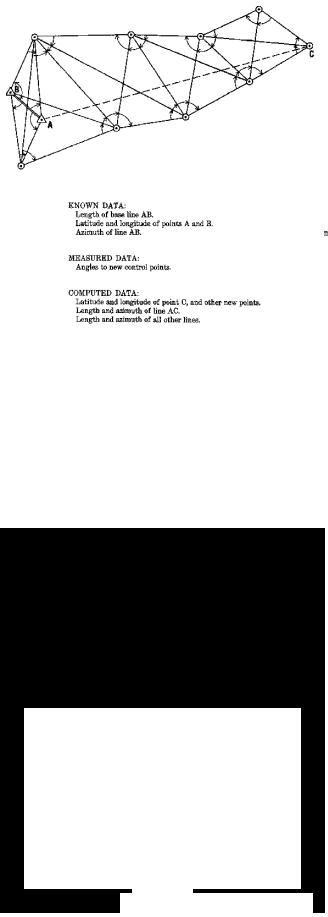
- •Text 1
- •Introduction
- •Text 2
- •Chapter 1 History of Geodesy
- •Text 3
- •Text 4
- •Text 5
- •Ellipsoid of Revolution
- •Text 6
- •Geoid
- •Text 7
- •Chapter III Geodetic Surveying Techniques
- •Text 8
- •Horizontal Positioning
- •Text 9
- •Triangulation
- •Text 10
- •Orders of Triangulation
- •Text 11
- •Trilateration
- •Text 12
- •Traverse
- •Text 13
- •Celestial Techniques
- •Text 14
- •Vertical Positioning
- •Text 15
- •Chapter IV Geodetic Systems
- •Text 16
- •Orientation of Ellipsoid to Geoid
- •Text 17
- •Text 18
- •Text 19
- •Text 20
- •Text 21
- •Text 22
- •Text 23
- •Text 24
- •Text 25
- •Text 26
- •Chapter V Physical Geodesy
- •Text 27
- •Text 28
- •Text 29
- •Text 30
- •Text 31
- •Text 32
- •Text 33
- •Text 34
- •Text 35
- •Text 36
- •Chapter VI Satellite Geodesy
- •Text 37
- •Text 38
- •Text 39
- •Text 40
- •Text 41
- •Text 42
- •Text 43
- •Text 44
- •Text 45
- •Text 46
- •Text 47
- •Text 48
- •Text 49
- •Text 50
- •Text 51
- •Text 52
- •ГЕОДЕЗИЧЕСКИЕ ТЕРМИНЫ
Meridian is obtained. The difference between the time at the point and the time at Greenwich is used to compute the astronomic longitude of the point. Since a point of the earth rotates through 360° in 24 hours, the difference in local time between two points can be easily converted into difference in longitude.
Another astronomic observation related to horizontal positioning is the astronomic azimuth. Very accurate azimuths are used in the controlling of the orientation of first-order triangulation which is the next topic to be discussed. Referring again to Figure 4 and to point P, the astronomic azimuth of some other point Q as seen from P is defined as the angle between the meridian plane of point P and the plane containing both Q and the perpendicular to the geoid at P. This angle is reckoned from north at P clockwise from O° to 360°.
Astronomic observations are made by optical instruments – theodolite, zenith camera, and prismatic astrolabe – which all contain leveling devices. When properly adjusted, the vertical axis of the instrument coincides with the direction of gravity and is, therefore, perpendicular to the geoid. Thus, astronomic positions are referenced to the geoid. Since the geoid is an irregular, nonmathematical surface, astronomic positions are wholly independent of each other.
|
Text 9 |
either … or … |
либо … либо … |
compensate for … |
компенсировать |
so that |
так что(бы); с тем чтобы |
as carefully and accurately as |
как можно тщательнее и точнее |
possible |
|
resistant to … |
имеющий сопротивление воздействию … |
result from … |
вытекать из |
in a manner |
способом |
reduce to a minimum |
сокращать до минимума |
fill in with … |
заполнять чем-нибудь |
|
Triangulation |
The most common type of geodetic survey is known as triangulation. It differs from the plane survey mentioned earlier in that more accurate instruments are used; instrumental errors are either removed or predetermined so that they can be compensated for in the computations and more rigorous procedures are employed to reduce observational errors. Another very important difference is that all of the positions established by triangulation are mathematically related to each other.
11

Basically, triangulation consists of the measurement of the angles of a series of triangles. The principle of triangulation is based on simple trigonometric procedures. If the distance along one side of a triangle and the angles at each end of the side are accurately measured, the other two sides and the remaining angle can be computed. Normally, all of the angles of every triangle are measured for the minimization of error and to furnish data for use in computing the precision of the measurements (Figure 7). Also, the latitude and longitude of one end of the measured side along with the length
and direction (azimuth) of the side provide sufficient data to compute the latitude and longitude of the other end of the side.
The measured side of the base triangle is called a base line. Measurements are made as carefully and accurately as possible with specially calibrated tapes or wires of invar, an alloy highly resistant to changes in length resulting from
changes in temperature. The tapes or wires are checked periodically against standard measures of length (at the Bureau of Standards in the United States and corresponding agencies in other countries). The geodimeter and tellurometer, operating on electro-optical and electronic principles respectively, have replaced the older methods of base measurement in the recent surveys. The work can be completed more rapidly and accurately than with wire or tape. The laser equipped geodimeter has proven to be the most accurate and it can measure much longer distances without
12
